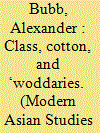|
|
|
Sort Order |
|
|
|
Items / Page
|
|
|
|
|
|
|
| Srl | Item |
| 1 |
ID:
155918


|
|
|
|
|
| Summary/Abstract |
This article makes use of a recently unearthed archive in Sweden, complemented by research in the India Office Records and Maharashtra State Archives, to explore the business networks of the small-scale railway contractor in 1860s Bombay Presidency. The argument centres on the career of one individual, comparing him with several contemporaries. In contrast to their civilian colleagues, freebooting engineers have been a somewhat understudied group. Sometimes lacking formal technical training, and without an official position in colonial India, they were distrusted as profiteering, even corrupt, opportunists. This article will present them instead as a diverse professional class, incorporating Parsis alongside various European nationalities, who became specialists in local milieux, sourcing timber and stone at the lowest prices and retaining the loyalty of itinerant labourers. It will propose that the 1860s cotton boom in western India provided them with a short-lived window of opportunity in which to flourish, and to diversify into a variety of speculative enterprises including cotton trading, land reclamation, and explosives. The accidents and bridge collapses of the 1867 monsoon, and subsequent public outcry, will be identified as a watershed after which that window of opportunity begins to shut. The article's concluding section analyses the contractors’ relationship with their labour force and its intermediary representatives, and strategies for defusing strikes. Ultimately, small independent contractors were agents of modernity not formally affiliated with the imperial project, and forced to bargain with merchants and strikers without official backing. Theirs is a record of complex negotiations at the local level, carried out in the immediate post-Mutiny settlement.
|
|
|
|
|
|
|
|
|
|
|
|
|
|
|
|
| 2 |
ID:
115046


|
|
|
|
|
| Publication |
2012.
|
| Summary/Abstract |
The Irish in India present an interesting case. Arguably a colonized people, the colonies of the British Empire ironically afforded them employment and profit on a large scale. Although studies have been made of Irish administrators, it was Irish soldiers that were most numerous and it is the 'stereotyped' Irish soldier who represents his nation in depictions of the colonial military. This paper first summarizes the Irish military involvement in India. The reasons why men joined the army in large numbers and, in particular, why they sought service in India, are explored. The regimental culture into which they were absorbed is also examined. The representation of Irish soldiers in officers' writings, both in fiction and popular media, is then discussed. The various aspects of the stereotype surrounding them are delineated, and the purposes of the colonial state served by their stereotypical representation are explained. Lastly, the reactions of Irish soldiers to their stereotype label are discussed. There were advantages to be gained from acting up to it, but it is argued also that soldiers found ways of rejecting bad or rebellious aspects of the stereotype and, by drawing on the 'good' or loyal aspects, helping to establish their own identity. Hence they manage to sustain and reconcile multiple national affiliations. Ultimately, however, the politics of Irish independence precipitates a crisis of identity which makes their position impossible. The paper concludes by considering the lives and memories of veterans of Indian service, and hence the afterlife of the Irish military identity beyond Irish independence.
|
|
|
|
|
|
|
|
|
|
|
|
|
|
|
|
|
|
|
|
|